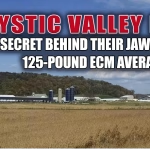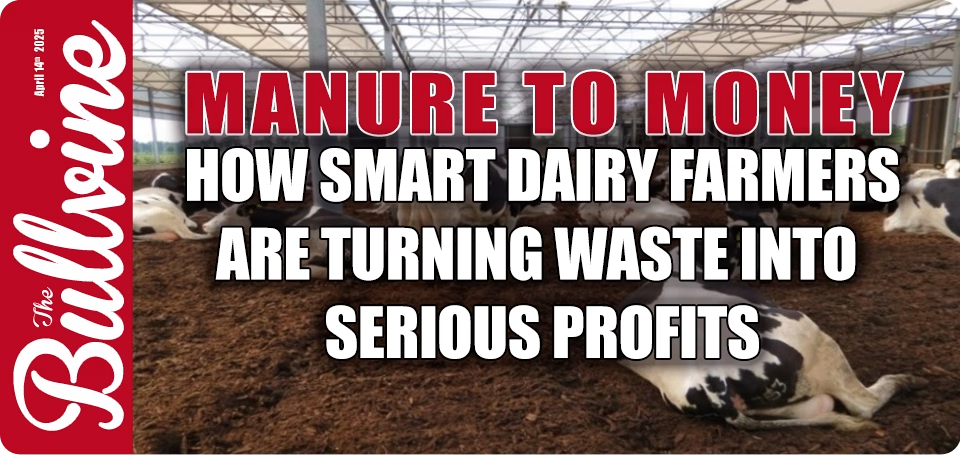Latest News
84% TARIFF SHOCK: How the US-China Trade War Will Reshape Your Dairy Business
125% tariffs slam US dairy exports to China—whey markets collapse, global trade reshaped. Can farmers adapt? EXECUTIVE SUMMARY: The US-China trade war has escal […]Is Your Herd Safe? Cybersecurity Essentials for Modern Dairy Farms
Robotic milkers & data-driven herds face invisible threats. Protect your dairy from cyberattacks risking livestock, milk checks, and operations. Your prize, […]Dairy Titans Unite: Arla-DMK Merger Reshapes Europe’s Dairy Landscape
Arla-DMK merger forms €19B dairy giant! 12k+ farmers, 19B kg milk. Will EU regulators bite? Game-changer for European dairy. Dairy Titans Unite: Arla-DMK Merger […]FMD at The Doorstep: Why Poland’s Dairy Industry Is Holding Its Breath
Poland's dairy sector faces a 'ticking bomb' as FMD outbreaks creep closer. Can biosecurity measures prevent economic catastrophe? EXECUTIVE SUMMARY: Poland’s $ […]CME Dairy Market Report: April 14, 2025 – Cheese Prices Surge on Active Trading Despite Bearish USDA Outlook; Butter, Powders Remain Static Amid Market Pause
Cheese surges while forecasts fall! Today's dairy markets reveal a puzzling split as spot trading defies bearish USDA outlook. What's driving this? EXECUTIVE SU […]
More News
- US-India Dairy Standoff: Why American Producers Face a Brick Wall in The World’s Largest Milk Market
- Royal Recognition: Dairy Ringmaster Murray Reissner Awarded Prestigious King Charles III Coronation Medal
- Quest For Success VII Delivers Impressive $7,155 Average at Maple-Leigh Futures
- The $1,000 Calves & $4,000 Springers: How Long Will This Gravy Train Keep Rolling?
- Global Dairy Market Faces Crossroads: Futures Signal Caution While USDA Surprises with Bullish Forecast
- Calf Rearing Revolution: How Investing $127 Per Calf Can Unlock $477 in Pure Profit
- Heat Stress in Heifers: The Profit-Killer You’re Ignoring
- Acid Test: Why Every Dairy Farmer Should Know About the H5N1 Milk Breakthrough
- Tech Reality Check: The Farm Technologies That Delivered ROI in 2024 (And Those That Failed)
- Spring Profit Surge: How Top Dairy Producers Maximize Seasonal Advantages
Top News Posts from Past Week
- Trump’s $998-A-Day Migrant Fines: Is it a Death Sentence for America’s Dairy Industry?
- Dairy’s Golden Calf Rush: $1,000+ Crossbreds Reshape Farm Economics
- $4,000 Heifer Shock: Replacement Heifer Prices Reach Record Territory
- Mega-Dairy Revolution: Inside the World’s 10 Largest Dairy Farms
- Milk Tsunami Ahead: USDA Exposes 2025 Price Crash Triggers
- The $1,000 Calves & $4,000 Springers: How Long Will This Gravy Train Keep Rolling?
- H5N1 Crisis Hits 1,000 U.S. Dairy Herds: California Epicenter and Nevada’s New Viral Threat Demand Immediate Action
- 84% Chinese Tariffs Slam US Dairy: Why Whey & Lactose Exports Face Crisis
- U.S. Dairy Farmers Unlikely to Cash in on Chinese Demand
- Viral Ground Zero: Austria Slams Borders Shut as FMD Threatens Europe’s Dairy Industry
Feature Articles
Mystic Valley Dairy: The Secret Behind Their Jaw-Dropping 125-Pound ECM Average
Wisconsin's Mystic Valley Dairy shatters records with 125 pounds of energy-corrected milk daily. Discover how "doing 100 little things right" creates extraordin […]MANURE TO MONEY: How Smart Dairy Farmers Are Turning Waste into Serious Profits
Dairy farmers are flushing away $15,000 per 100 cows annually. Discover how savvy producers are turning manure into a goldmine through strategic composting. E23 […]Hanoverhill Starbuck’s DNA Dynasty: The Holstein Legend Bridging 20th-Century Breeding to Genomic Futures
From $2,500 calf to genetic revolution: How one bull's DNA reshaped global dairy farming and still whispers in 83% of Holsteins today. E233 Hanoverhill Starbuck […]Revolutionary Colostrum Protocol Adding $500 Per Heifer to Your Bottom Line
Are you discarding liquid gold? Discover how extended colostrum feeding adds $500 per heifer while slashing treatment costs and boosting lifetime milk. E232 Rev […]2024 Holstein Canada Master Breeders: Excellence in Balance, Breeding, and Legacy
19 Canadian dairy farms earn elite 2024 Master Breeder status—discover the secrets behind their balanced breeding success! E230 2024 Holstein Canada Master Bree […]
More Articles
- Dad at 80: How Murray Hunt Revolutionized Canadian Dairy Genetics
- When Faith Meets Farming: Mark Yeazel’s Amazing Journey from Holstein Breeder to Tanzanian Dairy Missionary
- BLACK HIDE BLINDNESS: Why Breeding Only for Color is Destroying Your Dairy-Beef Profits
- Stud Wars: April 2025 – The Genetic Force Awakens
- From Show Ring to Genomic Legacy: The Transformative Impact of Aitkenbrae Starbuck Ada on Holstein Breeding
- Spring Pasture Powerplay: Balancing Grazing Efficiency with Milk Component Goals
- Unlocking Dairy Robot Financing: How Smart Farmers Are Funding Their Automated Future
- Rising to Excellence: The Remarkable Journey of Cord Hormann and Wilcor Holsteins
- April 2025 Global Holstein Evaluations: New Leaders Emerge as Genetic Progress Accelerates Worldwide
- Northeast Spring National Holstein Show 2025
Top Feature Articles from the Past Month
- Top 15 Best Milk Brands in the USA: Unveiling the Cream of the Crop
- Northeast Spring National Holstein Show 2025
- The Cow That Built an Empire: Comestar Laurie Sheik’s Unstoppable Genetic Legacy
- 10 Sires To Breed The Next World Dairy Expo Grand Champion
- Why Donald Trump Hates Canada’s Dairy Supply System
- Hanoverhill Starbuck’s DNA Dynasty: The Holstein Legend Bridging 20th-Century Breeding to Genomic Futures
- CAPTAIN: The Bull That Rewrote the Rules for Modern Breeding
- Making Dreams Come True: The Journey of Tom & Kelli Cull
- The $4,300 Gamble That Reshaped Global Dairy Industry: The Pawnee Farm Arlinda Chief Story
- Bull in a China Shop: How Juan Moreno Turned the Dairy World Upside Down
- Mystic Valley Dairy: The Secret Behind Their Jaw-Dropping 125-Pound ECM Average
-
Mystic Valley Dairy: The Secret Behind Their Jaw-D…
Karen Hunt Apr 15, 2025Wisconsin's Mystic Valley Dairy shatters records with 125 pounds of energy-corrected milk daily. Discover how "doing 100 little things right" creates extraordinary results. E235 Mystic Valley Dairy: The Secret Behind Their | RSS.com Ever wonder what it takes to run a dairy farm where cows pr… Read More - MANURE TO MONEY: How Smart Dairy Farmers Are Turning Waste into Serious Profits
-
MANURE TO MONEY: How Smart Dairy Farmers Are Turni…
Andrew Hunt Apr 14, 2025Dairy farmers are flushing away $15,000 per 100 cows annually. Discover how savvy producers are turning manure into a goldmine through strategic composting. E234 MANURE TO MONEY: How Smart Dairy Farmers Are | RSS.com While your neighbors complain about your farm's smell and regulators circle… Read More
- Hanoverhill Starbuck's DNA Dynasty: The Holstein Legend Bridging 20th-Century Breeding to Genomic Futures
-
Hanoverhill Starbuck’s DNA Dynasty: The Holstein L…
Andrew Hunt Apr 12, 2025From $2,500 calf to genetic revolution: How one bull's DNA reshaped global dairy farming and still whispers in 83% of Holsteins today. E233 Hanoverhill Starbuck’s DNA Dynasty: The Holst | RSS.com The legendary Hanoverhill Starbuck, pictured here at 5 years old by photographer Jim Rose, stands… Read More
- Revolutionary Colostrum Protocol Adding $500 Per Heifer to Your Bottom Line
-
Revolutionary Colostrum Protocol Adding $500 Per H…
Andrew Hunt Apr 11, 2025Are you discarding liquid gold? Discover how extended colostrum feeding adds $500 per heifer while slashing treatment costs and boosting lifetime milk. E232 Revolutionary Colostrum Protocol Adding $500 | RSS.com Your current calf feeding program may be limiting your profitability by up to $5… Read More
- 2024 Holstein Canada Master Breeders: Excellence in Balance, Breeding, and Legacy
-
2024 Holstein Canada Master Breeders: Excellence i…
Andrew Hunt Apr 10, 202519 Canadian dairy farms earn elite 2024 Master Breeder status—discover the secrets behind their balanced breeding success! E230 2024 Holstein Canada Master Breeders: Excelle | RSS.com The Holstein Canada Master Breeder shield represents the pinnacle of achievement in dairy cattle breeding – a… Read More
- Dad at 80: How Murray Hunt Revolutionized Canadian Dairy Genetics
-
Dad at 80: How Murray Hunt Revolutionized Canadian…
Andrew Hunt Apr 9, 2025At 80, Murray Hunt’s dairy genetics innovations still shape global herds—meet the visionary who made science the farmer’s ally. E229 Dad at 80: How Murray Hunt Revolutionized Can | RSS.com My father Murray Hunt at 80: The quiet visionary who transformed Canadian dairy breeding with scientific… Read More
- When Faith Meets Farming: Mark Yeazel's Amazing Journey from Holstein Breeder to Tanzanian Dairy Missionary
-
When Faith Meets Farming: Mark Yeazel’s Amazing Jo…
Karen Hunt Apr 9, 2025From elite Holstein breeder to Tanzanian missionary: How Mark Yeazel trades show rings for orphan care through dairy farming. E228 When Faith Meets Farming: Mark Yeazel’s Amazi | RSS.com You know what gets me? Stories about dairy farmers who entirely flip the script on their careers. And man,… Read More
- BLACK HIDE BLINDNESS: Why Breeding Only for Color is Destroying Your Dairy-Beef Profits
-
BLACK HIDE BLINDNESS: Why Breeding Only for Color…
Andrew Hunt Apr 8, 2025Black hide obsession is costing you thousands. Those cheap Angus straws? Economic suicide. Discover why color alone won't save your beef-on-dairy profits. E227 BLACK HIDE BLINDNESS: Why Breeding Only for C | RSS.com You're riding a fading trend, and your bottom line will pay the price. Since… Read More
- Stud Wars: April 2025 - The Genetic Force Awakens
-
Stud Wars: April 2025 – The Genetic Force Awakens
Andrew Hunt Apr 7, 2025Sexing Tech's 40% NM$ empire vs ABS's 68% polled coup – the dairy genetics galaxy will never be the same. E225 Stud Wars: April 2025 – The Genetic Force Awa | RSS.com The battle for Holstein genetic supremacy rages on in a galaxy not so far away. As we unveil the April 2025 sire share analysi… Read More
- From Show Ring to Genomic Legacy: The Transformative Impact of Aitkenbrae Starbuck Ada on Holstein Breeding
-
From Show Ring to Genomic Legacy: The Transformati…
Andrew Hunt Apr 6, 2025How one unassuming cow born in rural Ontario revolutionized Holstein genetics worldwide, bridging show ring glamour with genomic science. E222 From Show Ring to Genomic Legacy: The Transfo | RSS.com Do you know what amazes me about the dairy world? How a single cow can change everything. That… Read More
Tanbark Trail
Northeast Spring National Holstein Show 2025
March 31st, 2025 @ Hamburg, NY E217 Northeast Spring National Holstein Show 2025 | RSS.com The New York Spring Holstein Show, judged by Ryan Krohlow, showcased exceptional dairy cattle across multiple age divisions. The competition featured remarkabl […]Is Erbacers Snapple Shakira One of the Greatest Show Cows of All Time?
Uncover why Erbacres Snapple Shakira stands among the top dairy show cows of all time. What makes her excel in the competitive dairy arena? E55 Is Erbacers Snapple Shakira One of the Greatest Show Cows of All Time? From the moment she steps into the […]The Royal Winter Fair 2024 – Jersey
Judge Jeff Sales NTENSE JOEL DELPHIE ETGrand ChampionThe Royal - Jersey Show 2024WEEKSDALE/HI-CALIBER/ROCK ALLEN/F&D BORBA, BREADALBANE, PE c LEACHLAND VIDEO MOCHA K Intermediate Champion The Royal - Jersey Show 2024 WEEKSDALE HOLSTEINS, BRE […]The Royal Winter Fair 2024 – Holstein
Judge Blair Weeks JEFFREY-WAY HARD ROCK TWIGS Grand Champion The Royal - Holstein Show 2024 K. DOEBERIENER, L. BOWEN & PAT CONROY, R&F LIVESTOCK INC, & WALKER DAIRY INC. Grand Champion: Jeffrey-Way Hard Rock Twigs, 1st 4-year-old, K Doebe […]The Royal Winter Fair 2024 – Red & White Holstein
November 4th 2024 Judge: Markus Hehli, Rimbey, AB PREMIUM APPLE CRISP LILLY Grand Champion The Royal - Red & White Holstein Show BUTLERVIEW FARM, CHEBANSE, IL Grand Champion: Premium Apple Crisp Lilly (Apple-Crisp), 1st 5-year-old, Butlerview Far […]
The Bullvine LLC © 2025 | Terms of Use | Community Guidelines | Privacy Policy |
Manage Consent
To provide the best experiences, we use technologies like cookies to store and/or access device information. Consenting to these technologies will allow us to process data such as browsing behavior or unique IDs on this site. Not consenting or withdrawing consent, may adversely affect certain features and functions.
Functional Always active
The technical storage or access is strictly necessary for the legitimate purpose of enabling the use of a specific service explicitly requested by the subscriber or user, or for the sole purpose of carrying out the transmission of a communication over an electronic communications network.
Preferences
The technical storage or access is necessary for the legitimate purpose of storing preferences that are not requested by the subscriber or user.
Statistics
The technical storage or access that is used exclusively for statistical purposes.
The technical storage or access that is used exclusively for anonymous statistical purposes. Without a subpoena, voluntary compliance on the part of your Internet Service Provider, or additional records from a third party, information stored or retrieved for this purpose alone cannot usually be used to identify you.
Marketing
The technical storage or access is required to create user profiles to send advertising, or to track the user on a website or across several websites for similar marketing purposes.






























